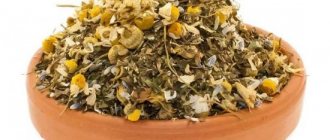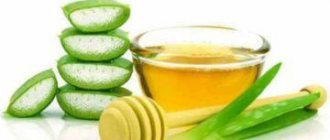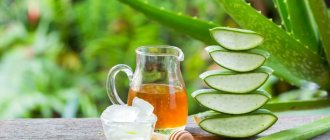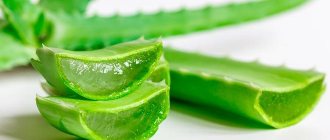The use of aloe juice and honey in the treatment of various diseases has become an example of classics among folk methods. Among the variety of medicines from the pharmacy, people still have faith in the help of natural remedies.
Aloe and honey for the treatment of gastric diseases are recommended by doctors of official medicine, often during the recovery period or in case of side effects of medications. The product is indispensable in the treatment of children with weakened immune systems. The secret of effectiveness depends on the correct choice of ingredients and adherence to the method of preparing the mixture.
Medicinal properties of aloe (agagave)
The chemical composition of the substances contained in aloe never ceases to amaze scientists. The leaves of the plant seem to be specially created to support the vital forces of the human body. Among the components found:
- about 20 amino acids, including almost the entire set of essential ones that humans cannot produce on their own;
- minerals that are part of enzyme systems and cells (potassium, copper, sodium, zinc, silicon, chromium, iron, manganese);
- vitamins, which are an indispensable means of preventing many diseases (A, group B, C, E);
- It’s worth mentioning folic acid, which is indispensable for the absorption of B12, except for aloe, it is found only in animal products, so if you are passionate about vegetarianism, it is this substance that provides the conditions for DNA synthesis and preserves human reproductive function.
The healing properties of aloe include:
- restoration of damaged cells and tissues, ensuring the regeneration process;
- relieving inflammation;
- fight against pathological microorganisms;
- moisturizing the skin and mucous membranes;
- stimulation of immunity;
- pain relief;
- activation of digestion;
- cleansing from decay products;
- improving blood circulation and blood cell composition;
- support of normal cholesterol levels;
- phytohormonal substances eliminate the effects of stress.
Almost any of these actions are useful in treating stomach diseases. The folk remedy enhances its properties when combined with honey.
How to choose the right aloe?
The name of the plant includes many different species. We are used to calling agave “tree aloe”; it grows well in a flower pot. However, it is most endowed with the beneficial composition of “aloe vera”. Its leaves are larger and are not green, but bluish-blue in color. The mass of such a leaf in nature reaches 700 g.
Aloe vera that is more than three years old is used for medicinal purposes.
Natural biostimulant
A common indoor flower, tree aloe is one of the most powerful medicinal plants used in the treatment of gastrointestinal diseases. Agave extract, which contains many biostimulating substances, helps stop the progression of inflammation and other destructive processes:
- anthraquinone and its derivatives, enzymes, ascorbic acid, steroid compounds relieve inflammation, have a healing and regenerating effect;
- minerals, chrysic, cinnamic, phenylacrylic organic acids, B vitamins regulate secretory activity;
- anthraglycosides, bitterness, phenolic and tannins, flavonoids destroy pathogenic microbes.
The medicinal properties of agave are recognized by official medicine, that is, scientifically proven. Several forms of drugs are used in clinical practice:
- sabur - condensed evaporated extract;
- syrup;
- pills;
- extractive solution in ampoules.
Most methods of use involve the use of aloe products for the stomach and intestines orally. At home, fresh juice in combination with other folk remedies is no less effective.
We recommend: Aloe for boils - traditional treatment recipes
To collect the healing liquid, an adult plant is suitable - from 3 years old and older, from the bottom of which you need to separate the thickest leaves. Additional biostimulation helps to enhance efficiency - storing raw materials at a temperature of +4-6°C without access to light for 12 days. A refrigerator is perfect for this. The shoots must be wrapped in paper or cloth (film cannot be used) and left on the shelf for the required period. Then wash the stems, discuss them, carefully cut off the skin and squeeze out the liquid from the gelatinous pulp.
Fresh extract is useful for gastritis with low acidity, lack of appetite, intoxication, peptic ulcer, malabsorption of nutrients, constipation.
Medicinal properties of honey
Honey has been used as a folk remedy since the advent of beekeeping, and before that people collected wild honey. He contains:
- 75–80% of the mass is carbohydrates (glucose, fructose, sucrose);
- beneficial vitamins (B1, B6, B2, E, C, K, carotene - a precursor to vitamin A), folic acid;
- minerals (potassium, silicon);
- phytoncides that destroy microorganisms;
- amino acids.
Everything except sugars is present in small quantities and is significantly inferior to aloe.
The effect of honey on the body:
- wound and tissue healing;
- bactericidal;
- choleretic;
- normalization of digestive juices;
- stimulation of the immune system.
How to choose the right honey?
Flower honey is produced by bees when they collect and process nectar from flowering plants. It is called after honey plants or is mixed. There is also a honeydew type of honey. It is obtained by bees from the sweet secretions of insects, aphids, and plant stems. It is characterized by a high content of microelements and has a greater tendency to crystallize.
Different healers give preference to their favorite varieties of honey. In late spring and summer you can buy liquid honey. At other times of the year, all varieties crystallize except chestnut and acacia. Bees produce May honey from various primroses, acacia, and linden. It is considered the most useful.
Light honey is considered the best for medicinal purposes. It is recommended to determine its quality by scooping up a small amount with a spoon and turning it around its axis.
An indicator of full ripening is that the honey is wound onto a spoon in the form of a ribbon and flows down in a continuous viscous stream.
When purchasing crystallized honey, you should pay attention to its consistency: there should not be too large crystals, a good composition is uniform, similar to butter. Large crystals mean the bees have been fed sugar. A 1 liter volume of ripe honey should weigh approximately 1.4 kg.
For what stomach diseases should you take honey with aloe?
The combination of honey with aloe has a combined effect and promotes:
- healing of stomach and duodenal ulcers;
- relieving inflammation in gastritis;
- normalization of acidity;
- rehabilitation treatment after surgical interventions on the stomach.
Stomach diseases often affect neighboring organs and disrupt the overall digestion process. Therefore, aloe with honey for treating the stomach is valuable for its properties:
- eliminate stasis of bile and pancreatic juice with concomitant damage to the digestive system;
- relieve pain and spastic muscle contractions;
- improve bowel movements;
- eliminate bloating;
- restore appetite;
- increase the weight of an emaciated patient.
There are many recipes and combinations. But to prepare the mixture, you need to correctly combine the ingredients and know the conditions for maximum healing effect.
The effect of honey
Honey has a systemic healing effect on the body. This is a real concentrate of biologically active substances. It contains essential amino acids, enzymes, natural sugars, and an almost complete composition of vitamins. All components of the product are easily digestible.
We recommend: Using aloe juice against dandruff - 3 simple recipes
For diseases of the digestive system, honey has an anti-inflammatory effect on the mucous membrane, soothes irritation, softens, heals damaged areas, stimulates the secretory activity of the stomach, pancreas, liver and gall bladder. To treat diseases, you need natural honey no older than one year.
Both aloe and honey promote the contractile function of all parts of the intestine, tone muscle fibers, and inhibit pathogenic microflora. When used correctly, they prolong the effect of drug treatment and prevent exacerbations.
How to prepare aloe juice?
In folk medicine, a decoction and alcohol tincture are prepared from aloe. The pharmaceutical industry uses not only leaves, but also stems as raw materials for aloe preparations. You can buy at the pharmacy:
- aloe syrup;
- tincture;
- aloe with iron;
- ointment;
- ampoule preparation.
Condensed aloe juice (sabur) is available on sale in powder form, then it is dissolved in water or alcohol for use. Aloe juice is best mixed with honey. To prepare it at home, you must follow some rules:
- It is not recommended to leave cut leaves that are at least three years old and 15 cm long or longer in the air for more than 3-4 hours.
- They should be placed unwashed in a dark bag and kept in the refrigerator for 2 weeks (just not in the freezer!). It has been proven that this period is necessary to enhance the concentration of natural biostimulants.
- After 2 weeks, wash the leaves, dry them, cut off the thorns, finely chop them and squeeze the juice through cheesecloth manually or using a juicer.
- Leaves can be stored in the refrigerator for up to a year.
- It is advisable to protect the juice from light and also place it in the refrigerator.
It is easy to peel the leaves using a thin knife.
It has been proven that the most allergenic part of the substances is contained in the aloe peel, therefore, for use in the treatment of children and sensitive people, it is recommended to cut it off first.
Contraindications
Despite the popularity of aloe treatment, not everyone can use the plant. So, with the following signs, treatment with a plant can harm the body:
- the presence of diseases of the gastrointestinal tract in an acute form;
- pathologies of the cardiovascular system;
- open bleeding, menstruation;
- hepatitis A;
- cystitis;
- nephritis;
- cholecystitis;
- haemorrhoids;
- pregnancy and breastfeeding period.
Treatment of children under 12 years of age with traditional medicine should be carried out with caution and only after consultation with a pediatrician. It is important to accurately determine the dose of use of the plant and take into account the child’s concomitant diseases.
Do not use aloe treatment under any circumstances if the patient is intolerant to this plant.
If there are contraindications, aloe in combination with other products can be used in small doses, if such is indicated by a doctor.
How to use aloe with honey for the stomach?
There are many recipes for using aloe and honey separately and in combination with various components to treat stomach diseases. The classic course of treatment should be followed for two months. Preventive repetition can be carried out in spring and autumn.
For the treatment of chronic gastritis it is recommended:
- Dissolve 100 g of honey in a glass of warm water, add ½ glass of agave juice. It is recommended to take a tablespoon 15–20 minutes before meals.
- The medicinal mixture works effectively if you combine 200 ml of aloe juice and honey, add 4 teaspoons of squeezed carrot juice. Also take before meals and treat for at least a month.
- If gastritis is accompanied by high acidity, then a special composition is prepared to reduce heartburn and painful attacks: take 2 tablespoons of honey and aloe juice, mix well and add a glass of potato juice. The mixture is recommended to be taken in the morning on an empty stomach. It is troublesome to prepare it every day, since the potato juice must be squeezed out immediately before use.
- For low acidity, it is suggested: first mix a glass of plantain juice with two tablespoons of honey, boil and place in a thermos. Leave for 2 hours, after which you can add a glass of agave juice to the lukewarm solution. You should drink before meals, mixing 2 tablespoons of the mixture with water. Can be stored in the refrigerator for no longer than two weeks.
You can increase the production of gastric juice in other ways:
- Dissolve a teaspoon of honey in ¼ glass of water, add to it aloe juice, a decoction of raspberry leaves, and plantain in equal parts. Take half a glass before meals.
- Dilute a teaspoon of cocoa powder in ½ glass of water, pour it into a ceramic bowl, add an equal volume of honey, butter and aloe in the form of crushed leaves, mix and place in the oven for 3 hours. Strain the cooled solution. A volume of 15 ml or a tablespoon is required per dose, drink before meals. Keep refrigerated.
Diseases of the stomach and intestines
Some of the most sensitive organs in humans are the stomach and intestines. The slightest error in food immediately makes itself felt.
What diseases of the stomach and intestines can honey help us with?
- for poisoning and gastritis;
- for upset and ulcers;
- for colitis, proctitis and duodenitis;
- with gastric erosion;
- Honey is used with caution in oncology. Depends on the patient's condition. The permitted recipe is a spoonful of honey diluted in warm water in the morning on an empty stomach.
See also
Ointment for back pain and joints with bee venomRead
Of course, honey is not a panacea; sometimes illnesses require treatment with medications. Your attending physician will definitely offer you the necessary treatment. But bee products can become indispensable helpers in the initial stages of the disease. Sometimes just one spoon of honey can relieve and soothe pain in the stomach and intestines. Therefore, we can conclude that honey is very useful for the stomach and intestines.
Recipes for stomach ulcers
For pain caused by ulcers, a mixture of aloe juice and honey helps the action of well-known medications. An example of combined treatment of stomach and duodenal ulcers is a mixture of equal volumes of honey, aloe juice, Vinilin, 1% solution of Novocain, Almagel and sea buckthorn oil. It must be stirred until a homogeneous mass is formed. It is recommended to take a teaspoon up to six times a day for 2 weeks.
A good healing effect is accompanied by the use of finely crushed 250 g of aloe leaves, honey and 0.5 liters of dry red grape wine. The mixture is heated in a water bath while stirring. Then leave for a week in a dark place. After straining you can take it. In the first week, take a tablespoon three times a day an hour before meals. With the second - the same regimen, but a teaspoon.
Are there any contraindications?
Any deterioration in health requires discontinuation of the drug. You can't test yourself and hope for improvement. Some people have an intolerance to honey or aloe, which can become worse when the stomach disease worsens. Moreover, if signs of allergies appear (skin rashes, itching, swelling of the face).
It is necessary to take into account the strong biostimulating effect of aloe. This means that the plant activates the growth of not only normal cells, but also malignant ones. Use is strictly contraindicated for patients with cancer of the stomach or other organs, polyps, or precancerous diseases.
General contraindications concern:
- pregnant and lactating women;
- patients with a tendency to frequent bleeding;
- hypertensive patients;
- persons with exacerbations of diseases of the urinary organs (cystitis, pyelonephritis).
Contraindications, side effects from the use of home remedies based on plants and honey
Despite the numerous advantages of home remedies based on bee products and indoor flowers, we should not forget about the prohibitions.
Article for you:
How to rinse your mouth with cloves to treat a sore throat
The main contraindication to alternative treatment is individual intolerance to the active ingredients. Taking the medication will result in serious adverse reactions and disruption of the digestive system.
Pregnant women and breastfeeding mothers should also not start treatment - there is a risk of harming the baby and causing disturbances in the development of the fetus. It is forbidden to take homemade compositions for diabetes mellitus, chronic diseases, pathologies of the heart, kidneys, and liver.
If you use home medications incorrectly, use low-quality ingredients, or overdose, there is a risk of getting an unpleasant bonus in the form of side effects.
The most common symptoms are intestinal disorders (prolonged diarrhea or constipation), nausea, vomiting, and headaches. Active components can also cause rashes on the skin.
Continuing treatment if adverse reactions occur is strictly prohibited. You should stop taking home remedies immediately; if the alarming symptoms do not disappear within 2-3 days, it is recommended to go to the doctor - you should not eliminate the unpleasant effects yourself.
"Cahors" with honey and aloe
Indeed, there is a popular recipe for the combined use of Cahors church wine and honey with aloe. “Cahors” is prepared according to ancient recipes from red grape varieties. It is characterized by a high content of flavonoids, which means it is capable of:
- enhance tissue regeneration;
- normalize digestion;
- lower blood pressure;
- have a positive effect on metabolic processes;
- cleanse the blood and remove toxins
- prevent the fixation of cholesterol plaques in the wall of blood vessels;
- improve organ nutrition.
Which wine to choose for treatment?
To prepare a folk remedy for treating the stomach, it is important to purchase real wine and not a fake one.
A Crimean product from Massandra wines is recommended; it is not necessary to buy expensive French analogues
You should pay attention to quality confirmation:
- the label should not contain the inscription “sweet table wine”; manufacturers label real “Cahors” as “special wine”, but such an inscription is optional;
- the strength of the drink is at least 16%;
- sugar content – 140–200 g/dm3, with less sweetness the wine is fake;
- packaging in transparent, colorless bottles;
- the drink must have a dark burgundy color, remain transparent, and when diluted with water, not change color or form turbidity;
- there is no sediment at the bottom;
- The thickness of “Cahors” is denser than ordinary wines, so after shaking the bottle, smudges appear on the walls near the neck;
- the same test can be carried out in a glass.











